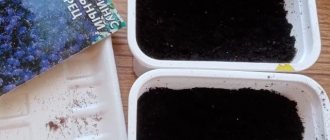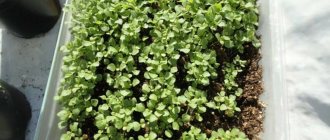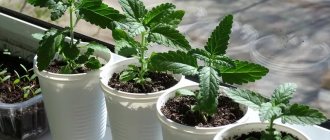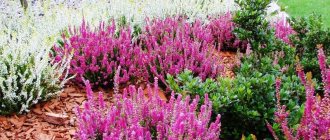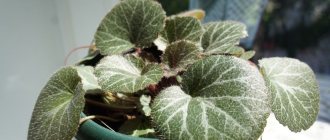A bright, colorful crop will be the highlight of any garden; it can decorate not only a flower garden in the open ground, but also be grown in flowerpots and hanging flower pots outside, on the balcony. The most popular variety in our gardens is the tuberous (ever-blooming) begonia. This variety is also often called “Hybrid”. In our climatic conditions it is grown as an annual crop. Growing seedlings is an important stage in plant development, so it must be approached with special attention.
What is tuberous begonia?
Tuberous begonia is a hybrid; it was obtained as a result of complex selection. Work on creating the plant began in the 19th century. The plant has a strong stem. The height reaches 60–80 cm. The leaves are large, can be completely glossy or covered with small fibers.
The flowering period is long - from May to October. The color can be varied. There are double, fringed, non-double, serrated and folded flowers. Depending on the variety, the diameter of the flower varies from 3 to 20 cm. With proper planting and care, flowering will be abundant and long-lasting.
What does the plant suffer from and methods of treatment
Tuberous begonia is a rather unpretentious plant, but if you do not follow the rules for its care, you may encounter the following problems:
- Curled leaves that have dried at the edges
may be a result of sunburn or high temperature; you need to move the begonia to a cool place. But if the leaves begin to fall off, it means the plant is cold. - Dull leaves covered with a thin web
are symptoms of the appearance of spider mites; to get rid of them, the begonia needs to be sprayed with any insecticide and take care of the correct level of humidity - at least 60%. - The appearance of rot both on the stem and on the leaves of begonia
is gray rot, which affects the plant due to excessive watering and stagnation of moisture, as well as regular contact with drops of water on the surface of the crown. In order to get rid of this, you need to review the plant’s watering regime - let the soil dry out after the previous watering, and treat the affected areas with crushed sulfur or a solution of colloidal sulfur. - Plaque on the leaves:
greenish-brown is another symptom of gray rot, white powdery is powdery mildew. In order to cure the plant, you need to treat it with a fungicide and move the begonia to a well-ventilated place. - The most dangerous diseases are very difficult to fight, so if begonia is affected by them, then in order not to infect other plants, it must be thrown away. These are root-knot nematodes and soft scale insects, which have very similar symptoms - growths and swellings on the stems
.
A mild fungicide that can be used frequently for preventative purposes is 1 tablespoon of baking soda per 3 liters of water.
Tuberous begonia - planting and care.
Main types and varieties
There are several types of tuberous begonia: erect and ampelous. They have a large number of varieties.
Varieties of erect tuberous begonia
Most varieties of tuberous begonia are erect. They are distinguished by fleshy stems. Popular varieties:
- Picotee Harlequin. The flower grows up to 25 cm. It has large double yellow flowers. There is a small red border. The petals are arranged in tiers, so the flower looks like a cone.
- Bouton De Rose. Low plant. It has double pink flowers with a diameter of up to 18 cm. The color is white and pale pink. The contrast of the border depends on the presence of sunlight and the level of air humidity.
- Dark Red. The low-growing bush has peony-shaped flowers of dark red color. They grow up to 10 cm in diameter.
- Crispa Marginata. Spreading flower, maximum height - 15 cm. The shape of the flowers resembles pansies. Color - white or pale yellow. There is a red border.
There are also erect begonias of the varieties Crispamarginata and Samba.
Varieties of cascading or ampel tuberous begonia
Ampelous begonia is distinguished by long and flowing stems with a large number of flowers. The most popular variety is Chanson. It has a large number of shades. The following varieties are distinguished:
- Begonia Boliviensis;
- Santa Cruz Sunset;
- Copacabana;
- Bossa Nova.
The shoots of Begonia Boliviensis first grow upward, and upon reaching 30 cm they begin to fall down and form a multi-tiered cascade. Shoots of Santa Cruz Sunset grow up to 40 cm. This variety is distinguished by red-orange fuchsia-shaped flowers. It is perfect for growing in pots.
Copacabana is an easy-to-care variety that tolerates excess sun. The plant has bell-shaped red flowers. The shoots of Bossa Nova reach 50 cm. The color is red, pink and orange. The flower has a fuchsia shape.
What types of begonias are there?
All varieties and hybrids of this flower are divided into three main groups, namely:
Plants with decorative leaves.
Small, slightly branched flowers, no more than 1 meter high, with beautiful unusual leaves.
- Royal begonia (Begonia rex)
- B. diadema (Begonia diadema)
- B. dotted (Begonia maculata)
- B. Mason (Begonia masoniana)
- B. powerful (Begonia robusta)
- Imperial begonia (Begonia imperialis)
This subgroup attracts lovers of beautiful and unusual-looking leaves.
Tuberous begonia growing in the garden video:
Samples with decorative flowers.
There are two subspecies: rhizomatous and tuberous. The first variety is capable of producing buds regardless of the time of year, which cannot be said positively about the second type. In winter, tuberous plants shed all their foliage and remain dormant.
- Begonia Lorraine
- Begonia boweri
- B. wintering (Begonia hiemalis)
- Begonia heracleifolia
- B. ever-flowering (Begonia semperflorens)
- B. tall (Begonia elatior)
- Tuberous begonia (Begonia x tuberhybrida) and its varieties - ampelous Limming Begonia (Begonia limmingheiana), or pendulous (Begonia x tuberhybrida pendula), multi-flowered (Begonia x tuberhybrida multiflora)
These constantly and abundantly blooming individuals invariably attract the gaze of others.
Bushy plants.
There are both upright plants and those with drooping stems. Flowers and foliage of this group are endowed with decorative qualities.
- Metal begonia (Begonia metallica)
- B. bright red (Begonia coccinea)
- B. red-leaved (Begonia x erythrophylla)
- Begonia nitida
- B. glaucophylla (Begonia glaucophylla)
- B. coral (Begonia corallina)
- B. manicata (Begonia manicata)
- Double yellow begonia (Begonia xanthina)
It is worth noting that some begonia varieties can belong to several groups at once. So metallic begonia can be either a bushy plant or with decorative leaves.
Common types of indoor begonias:
- Marmorata is the most popular and favorite variety among gardeners. First of all, because of its giant double snow-white flowers, and on the edge of each petal there is a thin pink line.
- Cleopatra (Begonia Cleopatra) or American maple. Highly decorative appearance with rich olive-colored leaves on the upper side and fluffy leaves on the lower part.
- Camellia (Camelia Flora pink-white) begonia in the form of a beautiful camellia, easily tolerates darkening, despite the bright red color with a white stripe on the edge.
- Gryphon (Gryphon Begonia hybrida) is a hybrid variety of decorative foliage royal begonia. Dark green leaves with black spots and silver veins look like the paw of a mythical griffin.
- Fimbriata is red and yellow, white and pink with a fringe along the edge of the double petal. Planting and care are not difficult.
- Pikoti is a multi-colored large-flowered begonia, with original colors of double buds: pinkish, white or golden with salmon edging.
- B. Red (double red) caring for red begonia consists of timely replanting, watering and removing inflorescences that have bloomed.
- Gloire de Lorraine is a profusely blooming beauty with pinkish flowers of varying shades.
- Chanson is an ampelous beauty with miniature, slightly terry-shaped flowers.
- Splendide Apricot (Begonia Splendide Apricot) is an ampelous pink-shaped begonia with amazing apricot flowers of different shades. Blooms from early summer until winter. Grows best in partial shade.
- Tiger - tiger begonia. It has unusual emerald leaves with bronze spots on the leaves. Caring for it at home does not require much effort.
Planting tuberous begonia at home
In order for tuberous begonia to delight with flowering, it must be planted correctly. All rules of agricultural technology must be followed. It is important to buy high-quality seed material.
What time of year is best to plant a flower?
In autumn and winter the plant remains dormant. It is recommended to plant the flower in early March. In this case, the begonia will quickly enter the vegetative stage.
How to choose the right tubers when buying
In many specialized stores, the sale of begonia tubers begins at the end of January. Main criteria for choosing planting material:
- absence of light spots;
- dark brown and uniform color;
- size no more than 4 cm;
- the presence of a depression on the top of the tuber.
It is not recommended to buy tubers that are too small. It is necessary to pay attention to the weight; if it is too small, there is a risk that the material is too dry. Such a tuber may not germinate.
Tubers purchased at the end of February or beginning of March should have awakening buds.
How to awaken tuberous begonia from the store?
To awaken tuberous begonia, it is necessary to create certain conditions. The optimal temperature for germination is 22–24 degrees. The tubers should always be on something damp and should not be exposed to sunlight.
If the tubers are partially buried in the ground and placed on a cold windowsill, they will take a very long time to sprout. The risk of rotting increases several times.
Treatment with drugs
Before planting, begonia tubers are soaked in a growth stimulator. It is recommended to use the drug Stimul or Epin. Treatment with a weak solution of fungicide or potassium permanganate will help reduce the risk of rotting.
Tuber preparation
The tubers must first be properly prepared for planting. They must be cleaned of rotten sprouts. If the onion is too large, it needs to be divided into several parts. The cut site is sprinkled with charcoal.
All manipulations with tubers should be performed as carefully as possible. They should not be dropped or squeezed.
Optimal soil composition
For good plant growth, it is necessary to choose the correct soil composition. Begonias prefer a nutritious and loose substrate with a neutral acid reaction. Soil composition:
- deciduous soil;
- peat;
- sand.
For 1 part sand and peat, take 3 parts deciduous soil. If desired, you can add a small amount of rotted cow manure.
Which pot is better to choose?
For planting begonias, it is recommended to choose wide but shallow pots. The plant has a shallow root system, so it will grow wider. The volume of the container should not be less than 3 liters.
This type of begonia does not have roots or fibers that will cling to the surface, so the material of the pot does not matter. You can use a plastic or ceramic container.
How to plant tubers
Initially you need to create a drainage layer. The pot is filled ⅓ full with expanded clay or other material. The prepared tuber is placed in a container filled with substrate. To do this you need to make a small recess. The tuber is placed in the ground with its growth points facing upward. It should be sprinkled so that the buds remain open.
When the young shoots grow to 4–5 cm, you need to add a little substrate to completely cover the tuber.
Caring for tuberous begonia after planting
It is recommended to place the begonia pot in a sunny place, but it should not be exposed to direct rays. A window sill with east and west windows is best suited. If the sun is too active, you need to create shade with a curtain or other plants.
The optimal temperature is 20–22 degrees. This is a tropical plant, so it needs adequate moisture. The soil should always be moderately moist. Water should not get on the tuber itself, as it may begin to rot.
What you need to plant begonia seedlings: choose soil, containers, seeds
By the time of sowing begonias for seedlings, it is necessary to prepare all the necessary equipment: seeds, soil, mixture, container, material for drainage. And it is very important to choose the right materials. Let's figure out what this crop needs for successful planting:
- soil of suitable quality . What are the soil requirements for begonia seedlings? Firstly, it must be light and loose so that it is well aerated and the root system develops normally, secondly, the soil must be nutritious so that the plants receive adequate nutrition, thirdly, slightly acidic soil is preferable (pH 5.5-6, 5). In this case, it is advisable to sift the soil through a sieve (mesh size about 5 mm). You can choose one of the options below and sow begonia in the following soil: Special soil for begonia.
- A mixture made with your own hands, consisting of turf or garden soil, high-moor peat, humus, sand (in a ratio of 2:2:1:1).
- Universal soil for flower seedlings.
- It is necessary to choose a suitable container: wide, low (about 7-8 cm). For these purposes, you can use a special seedling box purchased at a gardening store. Or you can find some kind of plastic container at home (food container, vegetable container, mushroom container). That is, there are no fundamental requirements for containers, the main thing is that it is convenient for you specifically. It’s good if you have a lid that fits this container. There should also be drainage holes at the bottom of the product.
- Prepare material for high-quality drainage . It is highly recommended to place a drainage layer at the bottom of the container, which will prevent moisture from stagnating. For example, you can use fine expanded clay, perlite, small pebbles, and broken brick. The normal layer thickness is 2-3 centimeters.
- It is important to choose quality seeds . It is better to give preference to products from a reliable manufacturer with a good reputation. Since the seeds are very small, it is not advisable to prepare them; you need to immediately sow them into the soil.
- By the way, you can buy pelleted (granulated) begonia seeds; they are much larger in size and more convenient to sow.
Rules for planting seedlings in open ground
The first step is to find a place to land. It should be well lit, but at the same time protected from direct sunlight and strong winds. The plant is planted in early June.
The tuber is pre-treated in a fungicidal solution and germinated. A plant with young shoots should be gradually prepared for planting outside. To do this, the flower is first taken out onto the balcony, and then simply into the fresh air. The duration of stay in the fresh air should gradually increase.
Preparing the planting site involves creating planting holes and filling them with ash or rotted humus. Then the plant is planted. Seedlings should be mulched immediately. Large tubers are planted at a distance of 30 cm from each other, medium ones 20 cm, and small ones - every 15 cm.
What tubers should you buy for growing begonias?
If you dream of growing a beautiful, lushly flowering begonia, then you should choose bulbs not in supermarkets, but in stores specializing in various plants.
The most suitable time to purchase tubers is February, since at this time they begin to arrive in stores from Holland. Do not focus on the label, because the most important thing in the choice is the planting material. In addition, under no circumstances wait until prices for a given product begin to decline, as this will indicate that the product is of poor quality, which means that you may not wait for the long-awaited flowers.
Your choice should be on a hard, not overdried tuber, which has no traces of mold or plaque. Often there may be more than 2 tubers in one package; be sure to inspect everything contained in the package. If you notice that one of the planting materials is of poor quality, you should put this packaging aside and look for larger bulbs. Give preference to those specimens that already have awakened buds.
We display the final result:
- High-quality and “correct” tubers will always be plump to the touch without bruises, brown in color, and not have suspicious spots;
- If the period is already suitable: the end of February or the beginning of March, growing buds should be present on the nodules;
- You should not rush at the emerging stem shoot, these are already overgrown tubers, and the shoot may be injured during planting.
How to properly store tubers
In winter, begonia tubers can be stored in an apartment or basement. Each of these options has its own nuances.
Storage in the apartment
In an apartment, it is recommended to store flower tubers in a cool place. This could be a place under a window or balcony door. The temperature should be in the range from 0 to 9 degrees.
There are 3 main storage options:
- In a box or crate. The tubers are sprinkled with sand, sawdust or peat.
- In pots. The container is transferred to a cool place, and all the green part is cut off. The soil needs to be watered periodically, it should remain slightly moist.
- In a refrigerator. The tubers are thoroughly dried, placed in bags with holes and wrapped in paper. They are best stored in the bottom of the refrigerator with fruits and vegetables.
When stored in pots there is a risk of rotting. To avoid this, the soil should be watered through a tray.
Basement storage
The basement should be dry and cool. A cellar for storing begonias is not suitable. It contains high humidity and planting material can begin to rot. The tubers are placed in a box or box. They must be covered with sawdust or sand.
Selecting a container for sowing
The most suitable container for begonia is considered to be a wide pot, about 8-10 cm high. Considering that the root system develops not in depth, but in breadth, such a pot is good for ventilation and access to oxygen to the roots. The capacity changes as the plant grows and develops.
For a young plant that has only recently taken root from a cutting or leaf, the container should have a diameter of about 6 cm. After 6 months, after the begonia has taken root and grown, it is transplanted into a pot with a diameter of about 12 cm.
You should also pay attention to the size of the plant and its age. When the begonia turns 3 years old, it should be transplanted into a container wider than the previous one. A small begonia should not be immediately planted in a large pot. If there is too much soil, the roots may rot and the soil will not have time to dry out.
Caring for tuberous begonia
Caring for begonias in open ground involves timely watering and fertilizing. Particular attention is paid to preparing the plant for wintering.
Lighting and locations
The plant should not be in the scorching sun. The light should be diffused. In the first month after planting, it is recommended to shield the flower from the sun with greenhouse film.
Temperature
Temperature is important for normal development. Optimal values are from 10 to 15 degrees. At low temperatures the flower will grow very slowly.
Watering and air humidity
Proper watering will help maintain flowering even in the hottest weather. The plant needs to be moistened early in the morning. The water should be warm. Daytime watering is dangerous due to the formation of burns and falling leaves. If you use cold water, the roots will die.
After completion of the active flowering phase, the amount of watering should be gradually reduced.
Feeding
In order for the plant to tolerate heat normally, it must be sprayed with growth substances. For example, Gumate, Zircon or Epin. Potassium nitrate improves the condition of foliage. After planting, it must be applied 2-3 times at weekly intervals.
After this, complex fertilizers are applied, with a small amount of nitrogen. If there is too much nitrogen, the begonia may begin to rot in wet weather. The last feeding is carried out in early October.
Wintering begonias
Closer to autumn, the leaves of the plant begin to turn yellow. At this time, you need to remove all buds and flowers. Feeding is stopped and watering is reduced to a minimum. Tubers are dug up before the first frost. They must be dried thoroughly in a warm room. The greens should dry completely.
The tubers are placed in sand or soil and stored at a temperature of 5–7 degrees. Periodically you need to moisten the soil and check the condition of the tubers. Planting material should not freeze.
Bloom
Club begonia is one of the ornamental plants. It has simple, double, two-color, large and small flowers. The flowering period lasts throughout the summer.
Begonia sowing time
The choice of time for sowing begonia seeds depends on the desire: to wait for flowering in the same year or the next.
For example:
- When sowing seeds in January, by summer the tubers will grow, the plant will get stronger and the begonia will bloom in August. However, it must be remembered that additional lighting will be needed. For these purposes, use a fluorescent lamp.
- If you sow seeds in February and March, the plant will not have time to gain strength and will bloom only the next year. But there is no need for additional lighting; caring for seedlings is not so difficult.
Propagation of tuberous begonia
There are several options for propagating tuberous begonia. This can be done by seed, dividing tubers or cuttings.
Growing tuberous begonia from seeds
This propagation method allows you to preserve the varietal characteristics of the plant. The growing process itself is long and labor-intensive. Seeds should be scattered on damp soil and covered with polyethylene. Place the container in a sunny place and spray it with water daily. Once a day, open the pot for an hour. If this is not done, the seeds may begin to rot from dampness. The optimal room temperature is 24 degrees.
The seeds should sprout in 2 weeks. When the sprouts have 2-3 leaves, they can be placed in cups.
Tuber division
For division, it is best to take old tubers. It is recommended to carry it out in early spring. Until the sprouts reach 4–5 cm, the tuber can be divided into several parts without damaging the plant itself. The cut areas are treated with charcoal powder or a special preparation.
After dividing, parts of the tubers are placed in different pots. Next, they need to be cared for as full-fledged plants.
Propagation of tuberous begonia by cuttings
Cuttings are the fastest and easiest method of plant propagation. You will need a shoot 10 cm long with several leaves. The cut is sprinkled with charcoal powder. Rooting should be done in moist soil in a bright and warm place. The soil should not touch the leaves of the cutting.
The planted cuttings are covered with a jar and ventilated daily. After 3 weeks it can be transplanted into a pot.
Features of plant propagation
Tuberous begonia (care at home ensures its flowering) reproduces in several ways. The most difficult thing is to grow begonia from seeds.
Growing from seeds
The most suitable time for sowing seeds is January. Begonias need time for their tubers to grow and form. Then it will have time to bloom in the same year. However, you need to remember about the short daylight hours, so the seedlings will have to be illuminated with a fluorescent lamp. Seeds should be sown following a certain sequence and rules.
Sowing and subsequent care of the plant consists of the following stages:
- Prepare a container and fill it with light, moist soil.
- Spread the seeds on the soil, but do not sprinkle soil on top.
- Place the container in a warm place, near heating radiators.
- Remove the glass every day to allow ventilation. Shoots will appear in 14 days.
- After germination, remove the film or glass.
- Place the container with plants on a bright windowsill, while protecting the seedlings from bright sunlight. To do this, they need to be slightly shaded.
- Water the seedlings in a timely and regular manner and do not let the soil dry out.
- With the appearance of the first permanent leaf, transplant the young plants into separate cups.
It must be remembered: in this type of begonia the tuberous part begins to grow very quickly.
Cuttings
Growing from seeds is considered a labor-intensive process, so many gardeners find it easier to root cuttings. The best time for this is spring or autumn. It is best to take cuttings grown from a tuber. They must be at least 8-12 cm.
In order for cuttings to grow on a tuber, preliminary work should be done. The tubers must go through a period of rest; for this they are placed in a cellar or refrigerator. The duration of this period is about 3 months. You can plant in January.
The tuber is removed, lightly dug into the ground and wait for the cuttings to grow. The temperature should be room temperature - about 20° C. Cuttings are considered ready for rooting when at least 3 leaves grow on them. You can get cuttings from a tuber twice, so when cutting them you need to leave the stem with the lower 3 leaves, cut with 2 leaves. The first flowers will appear in August.
The procedure for rooting cuttings is as follows:
- Take a cutting from a tuber, preferably sprinkle the cut area with ash or coal.
- Wait a few minutes for the cut to dry slightly.
- Deepen the end of the cutting into the soil 1.5 cm, water it with water. For rooting, it is better to use ready-made flower soil.
- Cover the top with a cap: a bag, a jar or a plastic glass.
- Ventilate the plants at least once a day by opening the hood for a while.
In about 3 weeks the roots should grow. The plant should be transplanted to a permanent place of growth, in a pot.
Dividing a bush or rhizomes
The bush of the plant is also divided into parts. To do this, remove it from the container and partially remove the soil by gently shaking it. Then it is cut into 2-3 parts with a knife. The cut areas are treated with ash. Each part must contain roots and about 2 shoots. They are planted in separate pots and watered.
Constant monitoring of soil moisture is necessary. It is advisable to cover the plant from above with a cap, then it will not wither and will take root faster and more painlessly. The tuber is divided in the spring, after buds have formed on it.
The figure shows how to propagate tuberous begonia by dividing the root.
This method is also not considered difficult if you follow the following algorithm:
- Take a plant about 3 years old.
- Remove the plant completely from the pot.
- Cut off the stem and leave the tuber.
- Rinse the tuber to remove soil.
- Take a sharp knife treated with an antiseptic. They cut the tuber into pieces so that each has at least one “eye” - a bud.
- Sprinkle the cut areas with ash or coal.
- To speed up the formation of roots, soak them in Kornevin solution.
- Plant each cut part in a separate container. Deepen it so that the bud is not underground, but outside.
- Water the plant and make sure that the soil does not dry out and the water in the container does not stagnate.
- Cover the top with a bag or plastic cup.
- After the cuttings have grown to a height of about 6-7 cm, sprinkle with soil and cover the rhizomes completely with it.
Leaves
Tuberous begonia (caring for the plant at home has its own nuances and subtleties) when propagated by leaves allows you to get a large variety of young plants.
To do this, you must follow a certain sequence:
- Select the bottom, large enough sheet. He must be healthy and undamaged.
- Cut the leaf along the edges to thick veins.
- Place the sheet on a hard, smooth surface and, using a sharp knife, starting from the middle of the thick vein, cut into triangles. Moreover, there must be a central vein in each leaf.
- Plant the particles in soil, which consists of sand mixed with peat. You can put them on top, lightly sprinkling them with soil along the edges of the sheet, or deepen them vertically, about 1 cm. The bottom cut should be in the soil.
- Cover the container with a bag.
An important condition for rooting is maintaining soil moisture and frequent ventilation of the plants. Sometimes the leaves should be sprayed with a spray bottle.
Young plants will appear in about 2 months. Gradually they will need to be accustomed to growing without a greenhouse, which is opened for a while. As soon as the sprouts grow, they are transplanted to a permanent place.
Questions and answers
How long does a flower live?
The lifespan of begonia is 2–3 years. However, some varieties with proper care can grow for up to 5 years. The tuberous begonias sold in stores are second-year plants. To rejuvenate a tuber, it should be divided.
How to care for tuberous begonia in autumn?
In autumn, the plant begins a state of dormancy. It lasts until spring. At this time, all excess leaves and shoots are removed. Watering is kept to a minimum. At a temperature of 10 degrees, the plant should be removed to a cool place.
How to wake up tuberous begonia
If the begonia tuber cannot be awakened, then it may be too dry. He can be revived. There are several ways. The first option is to wrap the tuber in a wet towel and place it in a plastic bag. It should be placed near the heating device. The tuber needs to be ventilated once a week.
The second option is to wrap the tuber in a damp cloth, perlite or moss. The plant is placed in a greenhouse.
How many days does it take for begonia to sprout?
In most cases, begonia seeds germinate in 10 days. However, the germination period can last from 8 to 26 days. Tubers begin to sprout only after a few weeks. First they form roots, and only then shoots.
Is it possible to pinch tuberous begonia?
Tuberous begonias do not pinch. Strongly grown shoots are simply suspended or attached to a high base. Hybrid tuberous begonias branch well without pinching.
At what depth should I plant tuberous begonia?
It is recommended to plant the tubers of the plant at a depth of about 5 cm. However, experienced gardeners recommend planting the plant so that the buds are visible. The soil is added as the shoots grow.
How to distinguish tuberous begonia from root begonia
The main difference between tuberous begonia and root begonia is the presence of tubers. This flower can be grown as a perennial garden plant or as an indoor plant. The thickness of the rhizome-tuber is about 5–6 cm. The stem itself is quite thin, but strong.
Why do tuberous begonia leaves curl?
Curling of leaves during the initial stages of growth is normal. This temporary modification will not affect the further development of the flower. This phenomenon is observed because the roots are still weak and the leaves do not have enough moisture.
To ensure normal self-regulation of humidity, a good drainage layer should be made. In this case, a sufficient amount of moisture will enter the leaves and they will not curl.
Care after landing
Tuberous begonias always need a lot of light. But direct exposure to the sun is excluded.
Rules of care during the first period after planting:
- Watering. Only after the substrate has dried to the depth of one phalanx of the finger. The penetration of moisture into the core is excluded for the entire life of the plant - water around, along the edges of the pot.
- There is no need to cover while waiting for germination. This is dangerous due to waterlogging of the tuber.
- Germination and rooting temperature is from 15 to 20°C. Lower is not allowed, higher is undesirable.
After 12-15 days, sprouts and leaves appear. As soon as their height exceeds the edges of the pot higher than 2-3 cm, the grower begins to add nutritious soil. A tall, strong shoot will find it easier to maintain an upright position when the soil level is higher.
Diseases and pests
Begonia is a capricious plant that needs constant care. If agricultural practices are violated, the flower may be attacked by insects and become sick.
Main pests:
- leaf nematode;
- greenhouse aphid;
- spider mite
The nematode attacks young shoots and buds, as a result the plant dies. To eliminate the pest, flower bushes must be treated with heterophos. Affected areas of the plant are removed and burned.
Greenhouse aphids feed on plant sap. To get rid of it, it is recommended to use tobacco infusion, soap solution or insecticides.
Spider mites form thin webs on leaves. After this they turn yellow and fall off. With severe infection, flowering stops and the plant dies. To combat spider mites, it is recommended to spray with an infusion of onion and garlic. Near the plant itself you need to place a container with chopped garlic.
Possible diseases:
- Powdery mildew. It affects the above-ground part of the plant. White spots of plaque appear and the leaves begin to dry out. To treat the flower, fungicides or a copper-soap solution are used.
- Gray rot. This fungal disease appears as gray spots. The plant needs to be treated with Benomyl.
- Bacterial spotting. Forms on the lower leaves in the form of small watery spots. For treatment, spraying with a systemic fungicide is carried out.
- Tomato virus. Yellow-green spots form on the leaves. Affected plants are destroyed.
The main reason for the development of diseases is constant waterlogging, which promotes the proliferation of pests. Improper care leads to the development of diseases.
Transplantation to a permanent place
Often, a young plant that has just grown from seeds or leaves has to be transplanted to a permanent place of growth. Sometimes a cutting that has already rooted well is replanted.
For good rooting of the plant, it is recommended to follow the following rules:
- Take a prepared pot, preferably short but wide in diameter.
- Place a drainage layer in the form of pebbles, expanded clay, or broken bricks at the bottom.
- Sprinkle a little charcoal as a protection against waterlogging, about 1 cm.
- Fill the pot halfway with substrate.
- Remove the plant from another pot. If this is difficult to do, in order not to damage it, wet the soil well or place the pot in a basin of water.
- Remove some of the old substrate from the roots and place the plant in the center of another pot.
- Fill the pot with soil, leaving about 1.5 cm on top.
- Be sure to water the plant. If the soil settles a little, it is advisable to fill it up.
- Considering that the root system is damaged during replanting, in order for the adaptation process to go faster, it is necessary to water the soil with Kornevin or succinic acid. The product can be purchased at a pharmacy.
- During the first days, shade the flower from the sun.
Some difficulties when growing tuberous begonia
When growing tuberous begonia, an inexperienced grower may encounter a number of problems. The main ones:
- yellowness of leaves - lack of light or insufficient watering;
- brown tips of leaves - the air in the room is too dry;
- buds falling off - too much moisture;
- leaf falling means lack of light.
You can get rid of such problems only by eliminating the cause. Further proper care will help to avoid them.
Tuberous begonia can be used both as an ornamental plant in the garden and as a home flower. To ensure abundant and lush flowering, maintain the correct temperature and water conditions.
What affects germination?
In order for begonia seeds to sprout together, it is necessary to create favorable conditions. These include maintaining optimal temperature and maintaining soil moisture.
It is necessary to wait a maximum of about 3 weeks for seed germination. If they do not sprout, you will need to sow them again. We must remember that it is not easy to germinate begonia seeds. It has been observed that the germination rate is generally around 50%.
How to plant a plant
In our climatic conditions, tuberous begonia can only be grown as annual plants.
In the summer, rhizome species of the flower are grown in a flower garden, and in the winter they are dug up, transplanted into a container, and brought into a warm room.
The most common method is to grow in pots, which can be moved from the garden to the house when bad weather occurs. Sometimes there are no visible reasons for concern, but constant movement can lead to the formation of more regular flowers than double ones. This is precisely the reason that before planting begonias, you should carefully choose the location, as well as the most suitable variety for you.
The site should be located in partial shade, where there will be no drafts. In our climate, rhizomatous ever-flowering species, as well as tuberous begonias, can grow without much difficulty. Other species will also be able to grow on closed loggias or verandas.
Choosing soil and pots
The pot for begonias should be 2 cm larger than the tubers of the plant with soil. And at its bottom there must be holes that prevent rotting of the roots.
After about six months, when the begonia's root system has grown, the pot will need to be changed, choosing a container 10-12 cm larger. If you are planning to plant a tuberous flower, you can immediately purchase a pot with a diameter of at least 15 cm - it loves space.
When replanting a plant, take a pot that is not much larger than the previous one. If the pot is too large, the rhizomes will take a long time to form, which will lead to impaired flowering. It is best to buy ceramic flowerpots that allow air to pass through.
You can purchase ready-made soil or make it yourself. The main condition for the growth of begonia is looseness and lightness of the soil. The acidity level should be fairly moderate, neutral.
It is best to mix turf and leaf soil with compost in equal proportions. It will be useful to add another tenth of the humus. Such soil will ensure optimal permeability of air and moisture. Thus, the root system will receive the necessary oxygen, which will prevent it from rotting.
Cuttings
This method is most often used to propagate bush begonias.
How to grow a flower from a cutting? It must be placed in water and covered with polyethylene. The cutting must have at least two buds and a cut on both sides. And it should be placed in water immediately after circumcision, so that it does not have time to dry out.
After the roots appear, the cuttings can be moved to pots and placed in a well-lit place.
How to replant a flowering begonia from a store
First of all, you should remember that you need to replant a houseplant only when it no longer fits in its container and the roots extend beyond.
- According to the rules, this procedure is carried out no earlier than March and no later than May.
- Carefully remove from the container.
- We clean the roots from the remnants of old soil.
- Place in a weak manganese solution for 15-20 minutes.
- We remove all damaged and diseased roots, sprinkle all cut areas with crushed coal.



